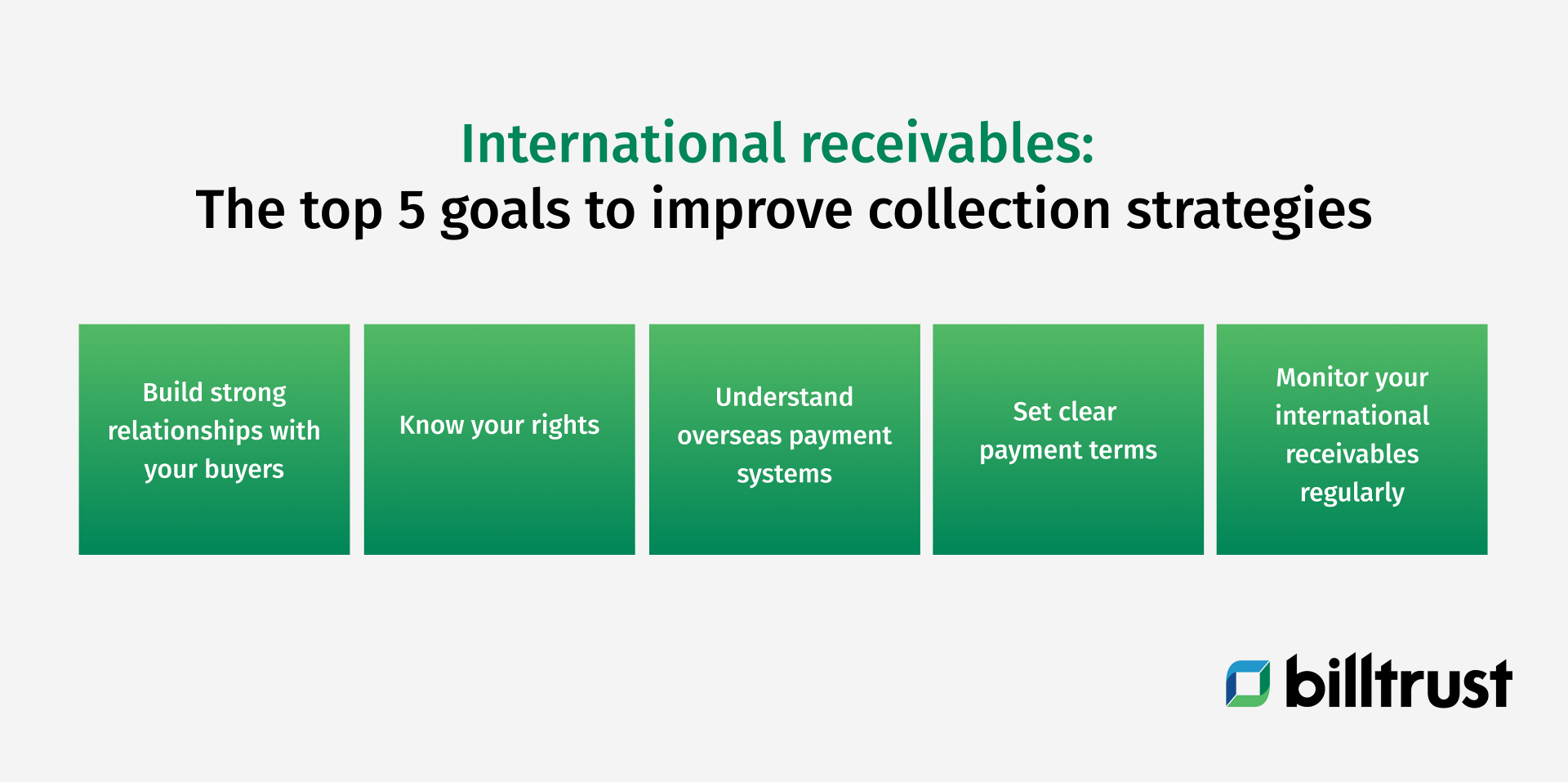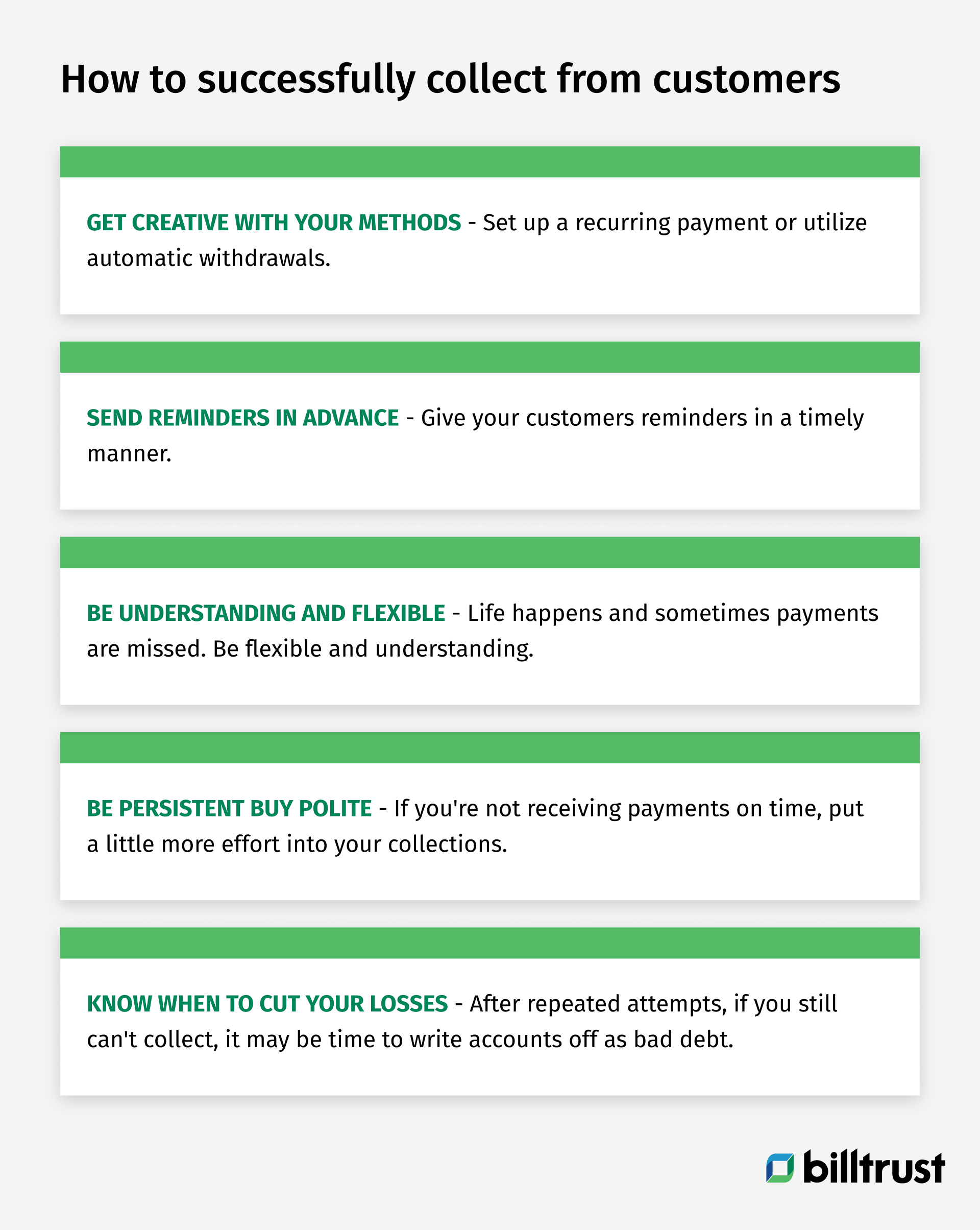Because you're expanding into new markets doesn't mean that collecting payments from customers in those markets has to be complicated. There are many ways to streamline the process and make it more efficient.
Below, we’ll unpack the types of receivables, the top ten questions you should ask about streamlining international receivables, tips and more to ensure that you always enjoy an up-to-date global receivables platform.
The three major types of receivables
Accounts receivable (AR) are funds a company owes from its customers for products or services that a customer has received but not yet paid for. In other words, receivables are IOUs. These accounts receivables are assets on a company's balance sheet because they will eventually be turned into cash.
Below are three major types of receivables: trade, nontrade and deferred revenue.
Trade receivables
Trade receivables arise when a company sells goods or services to another company on credit. The customer receives the merchandise with an invoice and payment terms. The customer pays the invoice according to the specified terms, typically 30 days.
Non-trade receivables
Nontrade receivables are IOUs from people or entities that are not the company's customers. An example is if your company loans an employee money to purchase a car. The employee would then become a debtor, and you would classify the money they owe as a non-trade receivable.
Deferred revenue
Deferred revenue is revenue that has been collected but not yet earned. An example would be if you sell a one-year gym membership for $1,200, but the customer only pays $100 upfront, with the remaining $1,100 to be paid in 11 installments over the next year. The $100 would be deferred revenue because your company has collected it but hasn't earned it since the customer still has 11 months left on their membership.

Accounts receivable: The most important goals
The goal of accounts receivable is to ensure that companies collect monies owed from customers promptly and efficiently. There are several factors to consider when trying to achieve this goal, and below, we’ll discuss some of the most important ones.
Factors to consider when setting goals for accounts receivable
- How much money does your customer owe you? This gives you a good starting point for setting your AR goals.
- How long does it take your customers to pay their invoices? Knowing this will help you set realistic goals for how quickly you expect payment.
- What are your credit terms with your customers? It helps you determine how much time you have to collect payment before it becomes delinquent.
- What’s the average time it takes to collect payment from each customer? Knowing this will help you set goals for individual customers based on their past payment history.
- What is the collection rate of each customer? This will help you set goals for individual customers based on their ability to pay their invoices in full and on time.
Accounts receivable is an integral part of every business, and there are several factors to consider when trying to achieve its goals. If you examine these factors, you will head in the right direction toward streamlining your receivables and improving your bottom line.
Download the ultimate guide to digital accounts receivable

10 questions to consider when streamlining international receivables
As the world becomes more interconnected, businesses are increasingly looking for ways to expand their reach and tap into new multinational markets. However, with this increased globalization comes increased risk—particularly regarding receivables.
Streamlining international receivables can help businesses minimize that risk and optimize their cash flow.
But what are the best ways to do that?
Here are ten questions to ask yourself when streamlining your business's international receivables:
- Are your global receivables ending up in a pile on your desk?
- How much time are you willing to invest to track receivables from different time zones?
- Are you willing to send paper invoices and accept check payments from countries with unreliable postal systems?
- Are you making the best use of technology, particularly AR automation software?
- What is your plan for handling currency fluctuations?
- Can you streamline your invoicing process to make it easier for customers to pay you on time?
- What late payment penalties are you willing to impose on customers who don't pay on time?
- Are you prepared to deal with the hassle of collections if payments are not received?
- What is your plan for dealing with bounced checks or other payment issues?
- Do you understand international receivables laws in your target market(s)?
No matter how big or small your business is, if you're looking to expand your operations into new markets, then you need to have a plan for managing your international receivables—and that starts with understanding the risks involved.
By taking the time to consider these ten questions, you'll be on your way to developing a streamlined process for collecting payments from overseas customers while minimizing risk exposure.
Streamlining international receivables can help businesses minimize that risk and optimize their cash flow.
International receivables: The top 5 goals to improve collection strategies
When it comes to collecting payments from foreign buyers, there are a few things you need to take into account. Cultural norms, payment types, time differences and varying legal systems, in particular, can make international receivables tricky. But with careful planning, you can ensure that you receive payments promptly - and without any headaches.
Below, we'll run through the top five goals you should set for your international receivables strategy. By following these goals, you can be sure that you're getting the most out of your receivables - and that your foreign buyers are happy, too.
1. Build strong relationships with your buyers.
The first step to successful international receivables is building solid relationships with your buyers. After all, if they trust and respect you, they're far more likely to pay on time and work with you on any issues that might arise. There are a few ways to build strong relationships with your buyers.
2. Know your rights.
Before you start chasing payments from overseas buyers, you must understand your rights under the law. Depending on your buyer's location, there might be different regulations governing payment terms and interest rates, so you must research before taking action. Once you know your rights, you can start taking steps to recover late payments without running into any legal trouble.
3. Understand overseas payment systems.
Banks typically handle all payments in many countries, so you must clearly understand how their systems work before chasing monies owed to you. By understanding the ins and outs of overseas payment systems, you can ensure a smooth payments process and that buyer's don't have any delays.
4. Set clear payment terms.
You’ll also want to set clear payment terms with your buyers immediately. When it comes to payment terms, clarity is critical, so make sure you spell out exactly when payment is due, what form of payment is acceptable and what will happen if you do not receive the payment by the due date. By setting clear payment terms early on, you can avoid misunderstandings down the road and ensure everyone is on the same page from day one.
5. Monitor your international receivables regularly.
Finally, it’s crucial to monitor your receivables regularly. By keeping tabs on who has paid and who hasn't, you can quickly identify any problem areas and take steps to address them before they become significant issues. Additionally, regular monitoring will help you spot any late payment trends giving you valuable insights into where you need to make improvements.
By following these five steps, you can be sure that your international receivables strategy is on track for success as long as you have a clear plan.

How to collect when nobody’s home
You've put in the hard work, made the sale, and now it's time to collect payments.
But what happens when your customer refuses to answer your collection attempts?
Of course, you could continue to hound them for payment, but we all know how effective those can be. The tips below can help you to improve your collection strategy so that you can collect payments even “when nobody's home.”
1. Get creative with your payment methods.
Many options exist nowadays for receiving payments, even when your customer isn't home. For example, you could sign them up for automatic withdrawals from their bank account or set up a recurring payment through PayPal or another online service. If they're not comfortable with that, you could leave a lockbox for them to drop the payment in. The key here is to make it as easy as possible for them to pay you.
2. Send reminders in advance.
Nobody likes being surprised with a bill, so give your customers reminders well in advance. A simple email or text message alerting them will ensure they’re not caught off guard by a small payment window or late fees.
3. Be understanding and flexible.
Things happen, and sometimes people can't make payments when they're supposed to be. If that happens, don't get angry or threaten until they pay you. That will only make them less likely to pay you next time. Instead, be understanding and try to work out a different arrangement. Maybe you can come by at another time or agree on another payment method. The important thing is that you keep the lines of communication open to come to a mutually agreeable solution.
4. Be persistent but polite.
If somebody isn't paying attention to your reminders or making any effort to work out a payment plan, it might be time to get a little more forceful in your collection efforts. But remember to be polite; getting angry and raising your voice will only worsen the situation and further damage your relationship with the customer. Instead, calmly explain the situation and what actions you plan on taking if they don't make an effort to work with you soon.
5 . Know when to cut your losses.
Some customers aren't worth the hassle anymore. After repeated attempts, if you still can't seem to get through to them or make any headway on getting paid, then it might be time to write it off as a loss and move on to someone who values your repeat business more.

Streamline your global receivables and get paid on time
By considering these tips and top ten questions about streamlining your receivables and following these five steps to resolve collections, you can be sure that your international receivables strategy is on track for success.
From building strong relationships with buyers to monitoring your receivables regularly, these tips and considerations will help you collect payments from abroad. With some effort, you can streamline your receivables process and ensure you're getting paid on time.

